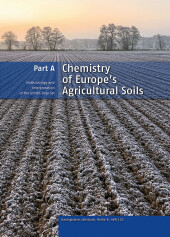 Neuerscheinungen 2014Stand: 2020-02-01 |
Schnellsuche
ISBN/Stichwort/Autor
|
Herderstraße 10
10625 Berlin
Tel.: 030 315 714 16
Fax 030 315 714 14
info@buchspektrum.de |

Manfred Birke, Alecos Demetriades, Clemens Reimann
(Beteiligte)
Chemistry of Europe´s Agricultural Soils, Part A, w. DVD
Methodology and Interpretation of the GEMAS Data Set
Ed. by Reimann, Clemens; Birke, Manfred; Demetriades, Alecos et al.
2014. 523 S. m. 358 Abb. 290 mm
Verlag/Jahr: SCHWEIZERBART´SCHE VERLAGSBUCHHANDLUNG 2014
ISBN: 3-510-96846-8 (3510968468)
Neue ISBN: 978-3-510-96846-6 (9783510968466)
Preis und Lieferzeit: Bitte klicken
During 2008 and until early 2009, a total of 2108 samples of agricultural (ploughed land, 0 20 cm) and 2023 samples of grazing land (0 10 cm) soil were collected at a density of 1 site/2500 km2 each from 33 European countries, covering an area of 5,600,000 km2. All samples were analysed for 52 chemical elements after an aqua regia extraction, 41 elements by XRF (total), and soil properties, like CEC, TOC, pH (CaCl2), following tight external quality control procedures. In addition, the agricultural soil samples were analysed for 57 elements in a mobile metal ion (MMI©) extraction, Pb isotopes and magnetic susceptibility. The GEMAS project thus provides for the first time fully harmonised data for element concentrations and soil properties known to influence the bioavailability and toxicity of the elements at the continental (European) scale. The provided database is fully in compliance with the requirements of the European REACH Regulation (Registration, Evaluation, Authorisation and Restriction of Chemicals).
The study also provides valuable information for other European pieces of legislation related to metals in soil.
The concentrations of many elements (e. g., As, Bi, Co, Cu, Li, Mn, Pb) in soils of north-eastern Europe are up to three times lower than in the South-West of Europe. The break in concentration occurs along the southern limit of the last glaciation and is thus directly related to geology. The variable geochemical background from north to south makes it impossible to define one soil background level for any chemical element that is valid for the whole of Europe. However, areas with increased metal concentrations can be clear- ly identified, and are most often associated with known mineral districts and mining areas. Some major cities (e.g., London, Paris) are marked by local anomalies of elements like Au, Hg and Pb, typically linked to anthropogenic activities. Element concentrations decrease rapidly towards the surrounding natural background with distance to any one anthropogenic source. For several elements (e. g., Hg, P, S, Se) the regional distribution patterns are strongly affected by climatic conditions favoring the development of organic soil. On all geochemical maps, the effect of diffuse contamination remains invisible at the chosen continental scale and sample density. To reliably detect contamination, mapping at a much higher sample density, i.e., at the local scale, is needed. Agricultural and grazing land soil samples show practically the same distribution patterns over Europe and very comparable element concentrations. This demonstrates the robustness of the low sample density geochemical mapping approach.


